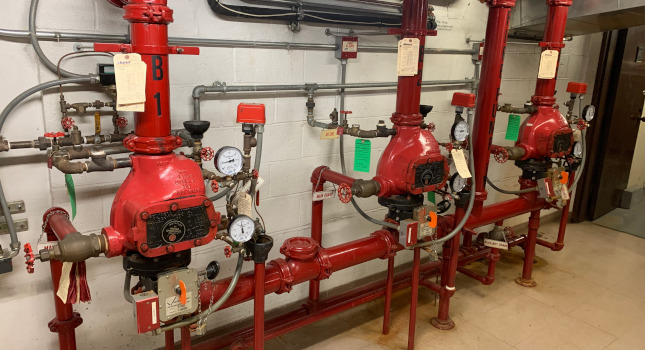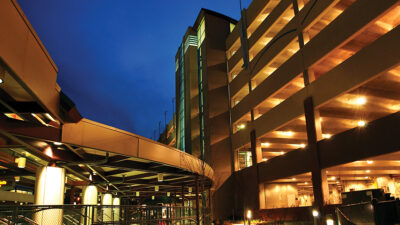The 2022 edition of NFPA 72 has a number of changes. These changes can be implemented before the adoption of the code to enhance a fire alarm’s system design

Learning Objectives
- Learn the key changes between the 2019 and 2022 editions of NFPA 72.
- Gain an understanding of changes impacting fire alarm system design.
- Become familiar with the organization of NFPA 72.
If you haven’t checked your inbox lately, you may have missed it. The 2022 edition of NFPA 72: National Fire Alarm and Signaling Code has been published and there are quite a few changes that will impact fire alarm design.
While the 2022 edition won’t be applied for some time in most jurisdictions, there are a number of changes to be aware of that could be incorporated into a fire alarm design before the adoption of the 2022 edition. If new code requirements are used that could be considered less restrictive than the current code provision, the authority having jurisdiction should be consulted to confirm that they will accept the new provisions.
New code requirements could be accepted under the equivalency provisions of the code. Federal government agencies typically apply the most recently published NFPA standards at the time of contracting for design services. If you are doing federal government work, you may be required to use the 2022 edition of NFPA 72 now.
This article addresses changes believed to be significant. It doesn’t address every change between the 2019 and the 2022 editions of NFPA 72.

Fire alarm definitions
There are several revisions to existing definitions and new definitions that have been added. The definitions in NFPA standards and codes have special meaning regarding the application of the standard or code. When applying the code, be aware that if a term is defined in Chapter 3, it may impact the application of the requirements.
Changes have been paraphrased below. The reader should review the actual definitions in NFPA 72.
- Cybersecurity — Protection of a system from theft or damage of data or hardware or software as well as from unauthorized command and control. This definition has been added to support a new chapter on cybersecurity and annex that provides guidance on cybersecurity.
- Two-way emergency communication systems — This definition has been revised to include area of refuge two-way ECS, elevator landing two-way ECS, occupant evacuation elevator lobby two-way communications systems and stairway communications systems. An elevator lobby two-way ECS is typically required by the building code when an area of refuge is not required.
- Master control station — This definition has been added to specifically address two-way emergency communications for rescue assistance. These systems include area of refuge, elevator lobby, occupant evacuation and stairway communication two-way communication systems. This change correlates with the title of UL 2525: Two-Way Emergency Communications Systems for Rescue Assistance, which is referenced in Chapter 24 as an applicable standard for listing purposes.
- Minimum hearing distance — This definition has been added to support the requirement in Chapter 18 limiting the maximum sound pressure level at the minimum hearing distance to 110 dBA. The minimum hearing distance is defined as the closest distance that an occupant’s ear can be from an audible appliance.
- Observation — This definition has been added to support new language added to Chapter 14 on testing addressing observations that may be made by testing and inspection personnel. An observation is a suggestion for improvement or enhancement of the fire alarm system that if not performed, it would not result in an impairment or code deficiency.
- Remote access — This new definition and annex material has been added to support a new section added to Chapter 23 — Protected Premises Systems, which adds requirements when fire alarm systems are being accessed remotely. The new section 23.8.2.11 allows remote access for testing and maintenance purposes including resetting, silencing or operation of emergency control functions under specific conditions. Resetting, silencing and operation of emergency control functions is only allowed for portions of the system that have been taken out of service. Qualified personnel are also required to be on-site when remote access for resetting, silencing or operation of emergency functions are being performed.
- Supervised notification appliance control circuit — This is an output circuit specifically used to activate notification appliance circuits on control equipment. This definition clarifies the code intent that a notification appliance circuit is not allowed to activate other notification appliance circuits. For example, connecting a notification appliance circuit to a power extender panel that would activate additional notification appliances would not be permitted. The circuit activating the power extender circuit would need to be a supervised notification appliance control circuit.


Chapter 7 — Documentation
Chapter 7 was added to NFPA 72 in the 2013 edition. The intent of Chapter 7 was to consolidate the requirements for documentation into a single chapter. The code only requires documentation where required by the AHJ or when required by applicable laws, governing codes or project specifications. The section on design documentation (7.3) has been revised to add language noting that pathway class designations and pathway survivability level designations are required to be provided when design documentation is required.
Chapter 10 — Fundamentals
Protection of control equipment — The requirement for providing smoke detectors at control units, power extender panels and supervising station transmitting equipment has been debated at the committee level since it was originally introduced in the 2007 edition of NFPA 72. The original provision for early warning detection at control equipment included an exception for fully sprinklered buildings. That exception was subsequently removed in later editions. The 2022 edition allows a risk analysis to be performed to determine whether early warning detection is necessary at control equipment, power extender panels and supervising station transmitting equipment. If the risk analysis supports not providing early detection, the elimination of the detection is still subject to the approval of the AHJ.
Abandoned fire alarm equipment — While it has always been a best practice to remove abandoned fire alarm equipment, the code has not addressed this in the past. New language has been added (10.4.7) specifically requiring that abandoned fire alarm equipment be removed and that if it is not removed when abandoned that it be tagged “out of service” until it is removed.
Battery capacity — NFPA 72 has required a 20% safety factor when determining the amp-hour capacity of batteries as a standby power source. The 20% safety factor has been in the code since the 2010 edition. The 2022 edition of the code requires a 25% safety factor be applied to the amp-hour battery capacity. This change is intended to require 80% of the battery capacity to still provide 100% of the standby load at the end of the battery’s useful life.
Battery listing — A new requirement has been added requiring rechargeable batteries used as secondary power for control units, devices and accessories to be listed. This requirement is effective Jan. 1, 2024, and will require battery manufacturers to subject their batteries to listing by a nationally recognized testing lab.

Chapter 11 — Cybersecurity
This edition of the code includes a general statement noting that cybersecurity should be provided for systems and communications addressed by NFPA 72 when required by governing laws, codes or standards. The guidance for providing cybersecurity has been incorporated in a new Annex J — Guidelines for Cybersecurity. The annex addresses cybersecurity standards, evidence and documentation guidance on compliance and certification maintenance. It also addresses aspects of firewall software updates and remote software changes.
Chapter 12 — Circuits and Pathways
Pathway survivability level 4 — A new level of pathway survivability has been added to the code. To meet a level 4 survivability, circuits are required to be provided with one-hour fire protection either by fire-rated circuit integrity cable, one-hour cable systems or one-hour fire rated enclosures.
It is important to note that when the code requires survivability, it is intended to address survivability from fire events. Survivability is also intended to allow for notification of occupants beyond the area of origin. If a building is designed for total evacuation, survivability is not generally required to be provided.
When survivability is required for partial evacuation and relocation scenarios in a fire event, the equipment required to provide notification to zones outside of the zone of fire origin need to be considered for survivability. Survivability requirements are not typically applicable to initiating devices or circuits not necessary for occupant notification.
The annex material to this section provides additional explanation and notes that level 4 protection is not intended to be better than level 1 protection. It provides an alternative method of providing a level of protection to meet the code requirements for buildings that may not be sprinkler protected and have less than two-hour rated construction.
Chapter 14 — Inspection, Testing and Maintenance
Visual inspection of supervisory signal devices and waterflow devices — Table 14.3.1 has been revised to require semiannual inspection of supervisory signal devices and waterflow devices. This is a change from requiring quarterly inspections. NFPA 25: Standard for the Inspection, Testing and Maintenance of Water-Based Fire Protection Systems still requires quarterly inspection of these devices in the 2020 edition.
“Wireless communications” have been added as a new component to the testing table (Table 14.4.3.2). The code requires an annual test of wireless communications in accordance with the manufacturer’s published instructions.
Footnote “d” to Table 14.4.3.2 has been expanded to indicate that automated testing of valve regulated lead acid batteries by the fire alarm control unit is an acceptable alternative method to prescriptive manual methods using test equipment. If batteries fail an automated test, the panel will indicate a trouble condition to indicate the need for battery maintenance or replacement. VRLA batteries are the most common batteries used for standby power for fire alarm equipment.
Chapter 18 — Notification Appliances
Notification appliance markings — Since the inception of mass notification systems, notification appliances that are used for signaling other than fire only events have not been allowed to be marked with “fire” on the appliance. This has been an issue with converting existing systems to be used for fire and mass notification.
The code is allowing devices to be field modified if the modification to the marking is done in accordance with the manufacturer’s instructions. The code will also allow a permanent sign to be placed adjacent to existing devices noting that they will operate to signal fire and other emergencies.
Distinctive evacuation signal operation — Previous editions of the code were not explicit regarding handling of the evacuation signal or duration of operation. The code now specifically requires the evacuation signal to operate until manually silenced or reset by authorized or emergency personnel. Where approved by the AHJ and when consistent with an emergency plan, the evacuation signal can be automatically silenced after 180 seconds.
Obstruction to visual notification appliances — Language has been added to the code to explicitly note that the effect produced by wall mounted and ceiling mounted visual devices should not be obstructed and should be considered in their placement.

Chapter 23 — Protected Premises Alarm and Signaling Systems
Operation of class A and class B radio pathways — The provisions for low-power wireless radio systems have been revised to include performance characteristics for the radio pathways. Class A and class B radio pathway performance characteristics have been added. Class A pathways have redundant paths while class B pathways do not.
Chapter 24 — Emergency Communications Systems
Pathway survivability — The criteria for pathway survivability have been revised to include level 4 pathway survivability for a building with a fire rating between one and two hours. The concepts are similar to those in the 2019 edition with additional clarifying language particularly regarding the equipment and pathways needing to be protected.
Area of refuge, elevator landing, occupant evacuation elevator lobby and stairway two-way communications systems — Criteria for survivability of these types of two-way communication systems has been added and revised. Circuits providing communication between rooms and areas in the building are required to be survivable based on the building construction. Circuits for off-site communication are allowed to have any level of survivability.
Chapter 29 — Single- and Multiple-Station Alarms and Household Signaling Systems
Resistance to common nuisance sources from cooking — Language has been added that requires smoke alarms and smoke detectors installed within 20 feet of a cooking appliance to be listed for resistance to common nuisance sources from cooking in accordance with the eighth edition of UL 217: Smoke Alarms, the seventh edition of UL 268: Smoke Detectors for Fire Alarm Systems or subsequent editions of those standards. This requirement is noted as being effective Jan. 1, 2023.
New Annex I — Color-Coded Tagging Program
This new annex provides a system that can be used by AHJs for tagging installations. The typical goal of these programs is to provide a readily accessible means of determining the status of a system following its most current inspection or test.
New Annex J — Guidelines for Cybersecurity
The intent of the new annex is to provide guidelines and a framework for implementing cybersecurity for systems that interact with the internet or with other systems that are connected to the internet.
Four specific documents addressing cybersecurity of systems and devices are referenced for use by manufacturers and installers. They include:
- ANSI/ISA/IEC-62443-4-2: Security for Industrial Automation and Control Systems, Part 4-2: Technical Security Requirements for IACS Components
- NISTIR 8259: Foundational Cybersecurity Activities for IoT Device Manufacturers
- NIST Framework for Improving Critical Infrastructure Cybersecurity
- UL 2900-2-3: Software Cybersecurity for Network-Connectable Products Part 2-3: Requirements for Security and Life Signaling Systems
This is a subject that will get more attention going forward. Specific requirements likely will move into the body of the code during the next code development cycle.
While these changes from the 2019 edition don’t address every detail, they do identify key changes that will be coming and that can be considered for implementation in current designs.




